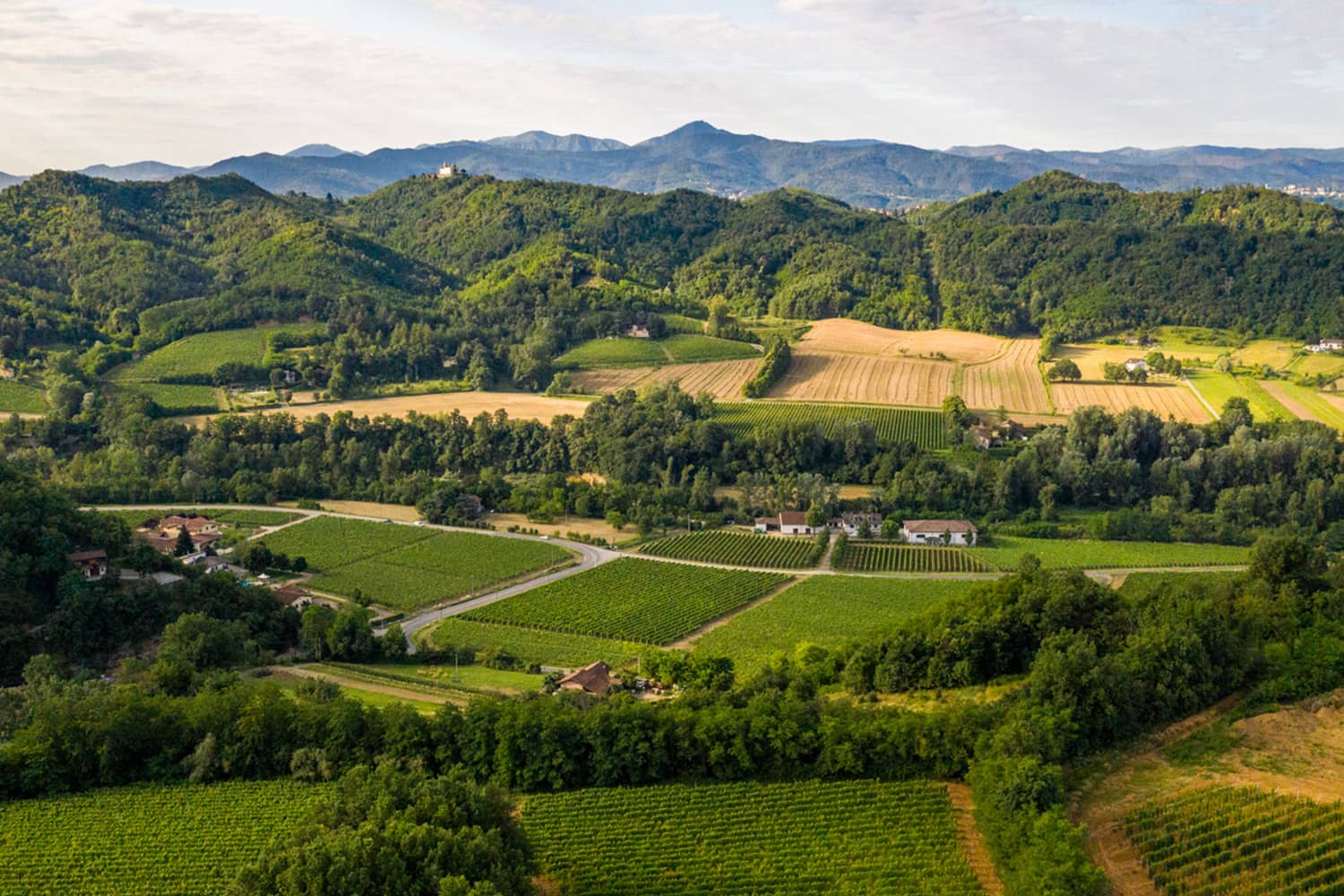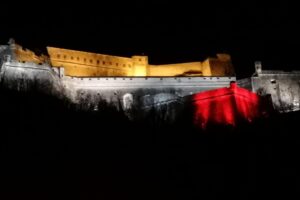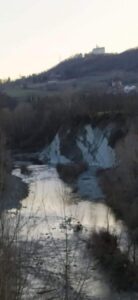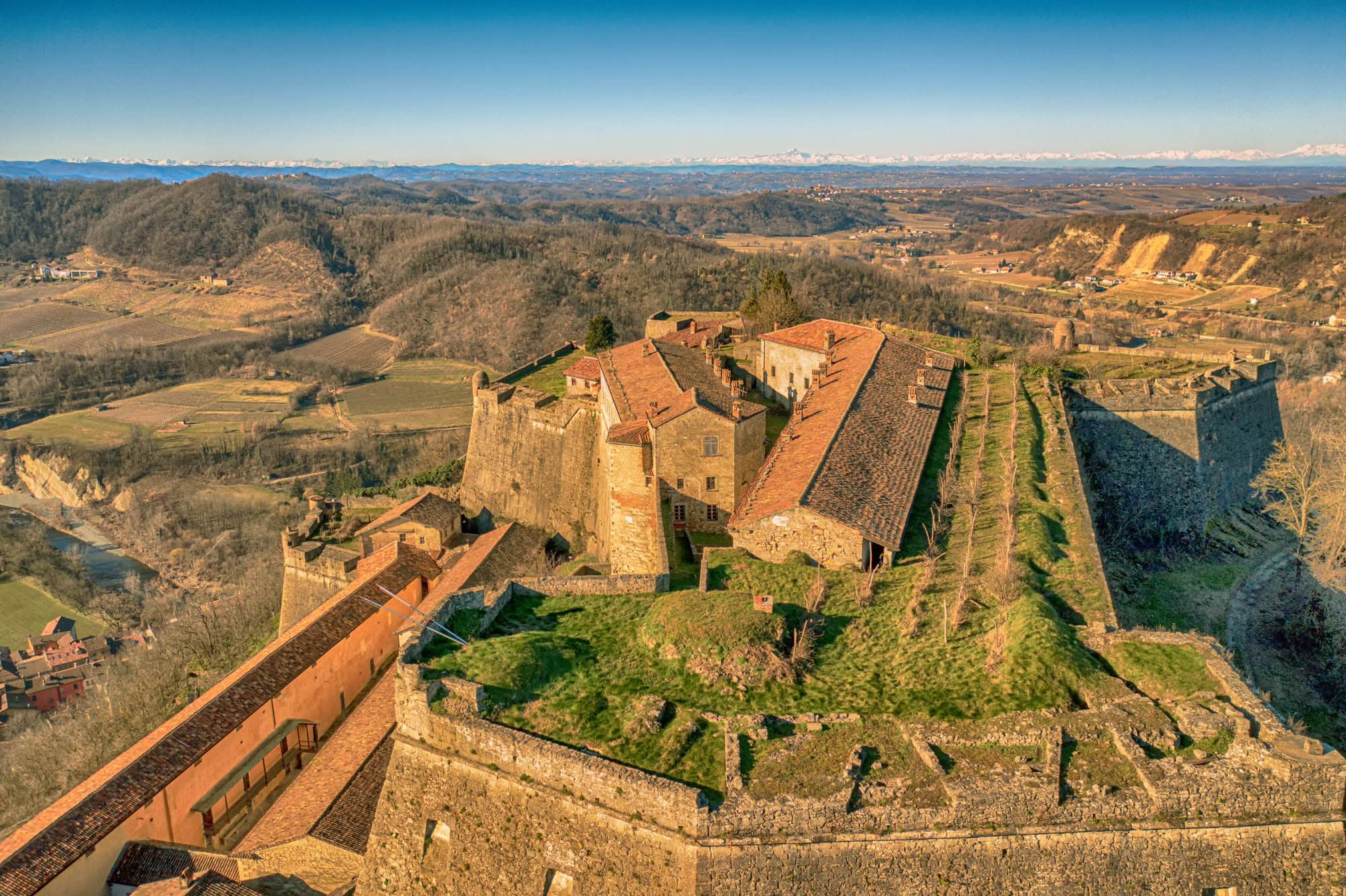A Neolithic black obsidian axe and traces of foundation piles of line structures, accidentally unearthed during work on the sports field, provide older archaeological evidence for the presence of an Archaic facies at the site where the urban settlement of Gavi would later rise.
A reference to Roman times is then suggested for the origin of the place name «Gavi»: a derivation from the personal name Gavius, widespread in Latin anthroponymy; another reference with the Germanic word gawi, understood as village or district.
The first reference to Gavi, contained in an archival document from 972, mentions it as a locus, that is, an early nucleus of agricultural population.
In 1006 some lands in the Gavi area were found to be in the possession of the bishop of Genoa. Other rural lands, on the other hand, are later donated in 1033 by Marquis Adalberto II (progenitor of the Adalberti of Gavi, Parodi and Massa) to the monastery of Santa Maria di Castiglione Parmense.
In 1815, after the fall of Napoleon, Gavi was assigned with the Ligurian Republic to Savoy’s Piedmont. Later the town was included in the province of Novi as part of the division of Genoa until 1859, after which it became part of the province of Alessandria.






What to see in Gavi
- BORGO MEDIEVALE
- GHETTO EBRAICO
- PONTE VECCHIO DEL LEMME
- CHIESA DI SAN GIACOMO MAGGIORE
- FORTE
- CONVENTO DI N. S. DELLE GRAZIE DI VALLE
- SANTUARIO DELLA MADONNA DELLA GUARDIA
One cannot visit Gavi and leave out the medieval village, now partly urbanized. The itinerary retraces the ancient “Strada del Pedaggio”, which began near the Maddalena tavern, on the fork between the Via dei Cavalieri di Vittorio Veneto and the Strada del Lemme. Today there is still a rural building that preserves traces of the original 17th-century structures.
Resuming the route along Via Voltaggio, near the ford to Bosio, we come across the Magdalen mill building: a mill already recorded in 1421 as the «Upper Mill near the church of St. Eusebius».
The reference to St. Eusebius, is one of the many testimonies concerning the existence of a monastery of the same name in the western Magdalene area: it is recorded between 1127 and 1462 as being dependent on the Benedictine Abbey of Santa Maria in Castiglione Parmense. In 1530 the monastery was then abandoned and gradually disappeared. A kiln was built on the same area, still existing in 1914.
GARIBALDI STREET AND THE CONVENT OF SANTA MARIA DELL’ANNUNZIATA
Via Garibaldi, wedged into the upper Mezzo district, is the old contrada del Carmine: in the area that now houses the municipal theater once stood the convent of Santa Maria dell’Annunziata. a building dating back to the second half of the 16th century, to which the Carmelites moved after the abandonment of the Monastery of St. Eusebius.
Inside the convent, there were six altars in 1528 but in 1798 it was expropriated by the Ligurian Republic and «the large building with the numerous burials of the Gavi families was abandoned to the studied will of destruction».
Among the works of art preserved inside the convent, an eighteenth-century wooden crucifix, some statues and the marble altar were able to be recovered, which, purchased by Monsignor Antonio Reggio, were donated to the oratory of the Whites. Monsignor Reggio also decided to have a small chapel dedicated to St. Mary of Mount Carmel, which still exists today, built on the edge of the area where the convent stood.
The church organ, on the other hand, was purchased by the Rosary Company and donated to St. James Parish.
A little further on one comes across the old hospital, now the Protected House. The hospital was erected on an earlier building in which a group of “beaten” or “flagellants” from southern France had been housed in the early 13th century. Initially the hospital was named after St. Christopher, and when rebuilt in the 16th century, it was arranged to separate the women’s bedrooms.
Resuming the route and walking down Mameli Street, one can admire the most important noble palaces in Gavi:
- Palace of Giovanni Battista Cambiaso, with the distinctive private chapel (1798);
- Palace of Giovanni Battista Marenco, with the two public ovens of Gavi attached;
- Palace built in 1705 by Pompeo Rocca;
- City Palace, dating back to 1589 and the historic seat of the City of Gavi;
- Palazzo Da Passano, which housed the elementary schools;
- Borlasca Palace, built in the 14th century and hosted Emperor Charles V in 1529;
- Rocca Sartorio Palace (renovated in 1641);
- Raggio Palace, ancient salt cellar;
- Palazzo Serra (formerly Pinelli gentile) from the 17th century.
THE PORTER
The gate of Bagnacavallo is referred to as Portino in toponymy and local custom. It is the only surviving “forgotten” gateway to the town of Gavi.
in fact its path, not very usual for access to the village, was mainly used to reach the mill below. Referred to as the “middle mill,” it was owned by the marquises of Gavi.
The door has a rectangular plan of a one-way type; the mullioned window on the façade, with a small column and simple Corinthian capital, together with the pointed arch on the ground floor, seem to date the work to the early 13th century.
THE ORATORY OF WHITE
Between Garibaldi Street and Hospital Street stands the oratory of the Brotherhood of Saints James and Philip, commonly referred to as the Oratory of the Whites because of the color of the hoods.
The confraternity was already listed in 1583 among those indicated by the apostolic visitor of the diocese of Genoa.
The oratory, restored in 1975, has a simple structure externally while the interior, with a single nave, was decorated in the 16th century with episodes from the Passion stories by Giovanni Agostino Ridolfi.
The wall paintings disappeared, following the installation of the two side altars and the organ, made by Carlo Serrassi in 1827.
Some works are still clearly visible:
The fresco of the Last Judgment, painted in the mid-17th century by Giovanni Battista Carlone; the processional crucifix attributed to Gerolamo del Canto; and the Baroque statues of the Immaculate Conception, St. Rocco and St. Limbania. Inside the oratory is an altarpiece by serravallese Bernardo Montessoro, depicting the Virgin and Child between Sts. Gottardo and Rocco, signed and dated 1608.
THE ORATORY OF TURCHINI
Next, adjacent to the hospital we find the oratory of the confraternity of N. S. Assunta, referred to as the confraternity of the Turchini.
It was originally called the Compagnia dei disciplinati di Santa Maria, appearing as early as 1582 to manage the Monte di Pietà, which granted loans to poor families without charging interest. This function was maintained by the Turchini until the early decades of the twentieth century.
Inside the church we find a single nave with a barrel vault, and valuable works of art are preserved inside, including: polychrome wooden statuette of Our Lady Immaculate, attributed to the 17th-century Neapolitan school; the fabric gonfalon worked with silver thread embroidery, depicting Our Lady of the Assumption on the front and St. John the Evangelist on the back. A silver astylar cross of French manufacture, referable to the early 18th century, is inserted on the gonfalon’s support.
The statue of St. Anthony Abbot from the deconsecrated Paraso chapel in Marconi Square.
The polychrome wooden statue of Our Lady of the Assumption, an egregious work by Bartolomeo Carrea, a sculptor from Gavi and active mainly in Genoa.
The Baroque wooden statue of St. Lucy and the marble statue of Our Lady of Grace, assigned to the second decade of the 17th century.
The chancel organ,was made by Pavia craftsman Giovanni Battista Lingiardi and put in place in 1824.
THE ORATORY OF ROSSI
Along the road leading to the Borgonovo district stands the oratory of the Holy Trinity brotherhood, traditionally called “dei Rossi».
The confraternity, witnessed from the second half of the 16th century and aggregated with the Archconfraternity of the Holy Trinity of Rome in 1609, operated the Grain Mount and a bakery built in 1670, later leased to private individuals with the obligation to sell bread and the foodstuffs at low prices.
The little church of the Reds has a barrel-vaulted nave inside and preserves numerous valuable artworks in addition to an organ built in 1879 by craftsman Camillo Guglielmo Bianchi.
Giuseppe Palmieri’s altarpiece depicting the Virgin and Child with Saints Augustine and Agatha;
the painting Ecce Homo, by Luciano Borzone; the painting Martyrdom of St. Sebastian, from the 17th-century Spanish school; The Holy Family with St. John, close to the stylistic features of Cambiasque Paggi.
Also kept in the oratory is a canvas with a secular subject, namely depicting the Continence of Scipio, made by Giovanni Raffaele Badaracco.
In Piazza delle Mura, referred to as Contrada delle Cricche, stood the small Jewish ghetto of Gavi.
Until the 19th century, Parodi’s Gate.
The building, which represents the most distinguished monument of religious architecture in Oltregiogo, was built during the rule of the Marquis of Gavi, at a time before 1172.
Significantly dedicated to St. James the Greater, it preserves the memory of an earlier hospice for pilgrims on the Campostella route.
It was originally included within the scope of the diocese of Tortona, only to pass to the diocese of Genoa in 1248.
The building is often assigned to the Lombard Romanesque facies, although there is no shortage of authoritative readings noting its «completely Genoese architectural structure».
EXTERNAL ASPECTS
The facade is the most intact part of the original building.There are sculptures that, it is speculated, were made by craftsmen who had worked in Genoa Cathedral in the previous decade on the portals of San Damiano and San Gottardo.
The lintel on the ‘entrance is decorated with a high relief, representing a Coena Domini: in the center is Christ towering over the twelve Apostles arranged symmetrically, six on each side, behind the perspective of the set table.
At the ridge of the gable of the doorway is carved, in the round, Samson riding a fair: a Christological Reference to the struggle against the powers of evil.
The tower has a nonequilateral octagonal structure from medieval times. The clock is inscribed in a typical Romanesque eye.
The major bell, put in place in 1352, bore the imprint of the heraldic symbol of the Visconti family, then lords of Gavi.
THE WORKS
At the bottom of the right aisle is a small late Gothic wall painting depicting Saints Sebastian and Rocco, discovered in 1967.
Towering above the high altar was the polyptych of St. James, made in 1478 by Manfredino Boxilio and now preserved at the Accademia Ligustica in Genoa.
This is followed, from the bottom of the right aisle, by paintings depicting the Dream of St. Joseph, by Giovanni Battista Poggi, and the Resurrection of Lazarus, by Bernardo Montessoro of serravallese.
There is also the altarpiece of the Madonna and Child between Sts. James and John the Baptist, the work of Gandolfino da Roreto.
The apse is adorned with a bronze statue of St. Joseph, made in the early 1960s.
Located in the chancel are: the painting depicting the Trinity and Sts. Jerome and Francis of Paola, and St. James driving out the Moors, by John Raphael Badaracco.
In the left aisle is the painting the Baptism of Christ, painted by Lazzaro Calvi in 1591.
The marble altar is surmounted by a marble statue of the Virgin with Child by Tuscan sculptor Carlo Cacciatori.
The final segment of the wall is decorated with a fresco of Madonna of Mercy, assignable to the last decades of the 14th century.
At the back of the nave is a polychrome wooden statue of Madonna of the Rosary, made in 1854 by Gavi sculptor Luigi Montecucco.
The fortification preserves the trace of a very old Byzantine construction, anchored on even more ancient foundations.
The central core of the arce incorporates memories of the ancient castle of the Marquises of Gavi: the access ramps, the two quadrangular towers, and the wall rising to the Bastion of the Standard.
There is evidence of the presence of St. Mary’s Church inside the castle, dating back to 1280, which, with the transformations that took place in 1628, was moved to the lower courtyard and dedicated to St. Barbara.
Two wells ensured water supply and there was a forge-foundry and a hand mill.
During the rule of the Marquises of Gavi, one of the towers of the castle was owned by Emperor Frederick I, who also owned a house in the village.
Occupied by the Genoese in the early 13th century, the fort returned to the Republic in 1528. In 1625, it resisted attacks by the Franco-Sabaud militia that had invaded the Lemme valley. In 1799, it remained the only fortification occupied by the French in Italy.a in the village.
Having fulfilled its military function, the fort was used as a civilian house of confinement and, particularly during World War II, as a military prison.
An imposing monument that, by singular fate, the nineteenth and twentieth centuries have handed down almost uncorrupted.
In the doorway within the tower, next to the Romanesque gate, there remains a visible trace of Lombard domination and the lordship of the Republic: a Visconti bison next to the cross of St. George.
The orderly design of the architectural furnishings, the symmetry of the lights, the patrol walkways, the drawbridges, and the associated flanking towers give the Gavi Fort an art content equal to a peaceful residential castle.
Shortly after the cemetery appears, isolated, the convent dedicated to Madonna of Grace.
In the Valle locality stood an organa shrine of the effigy of the Madonna and Child, where St. Bernadine preached between 1429 and 1431.
In 1455 a small chapel dedicated to the Virgin was erected, and a statue of the saint made by Spinetta Fregoso, lord of Gavi, was added to the old image of the Madonna.
In 1466 a church named after St. Bernardine was built, and in 1590 the foundation of the convent of Madonna of Grace was laid.
During French rule the structure passed to the public domain. The institution, initially officiated by the Augustinians, passed to the Carmelites and finally to the Friars Minor Observant.
The building consists of the church on the west and the convent building on the other sides, including cloister, garden and cloister.
The interior of the church has three naves defined by monolithic pillars and barrel vaults.
The marble high altar is surrounded by six shrines dedicated to St. Francis, Our Lady of Grace, St. Paschal Baylon, St. Bovo, St. Anthony of Padua, and the Immaculate Conception.
All the altars were put in place between 1754 and 1755, replacing the previous ones.
On the feast of St. Bovo, a cattle fair was held in the churchyard.
THE WORKS
Preserved in the Convent is a marble statue that offers a very realistic interpretation of the figure of St. Bernadine, dating back to 1455.
The organ, the work of craftsman Camillo Guglielmo Bianchi, was installed in 1900.
At the bottom of the cloister gallery is a wall painting depicting the Tree of Franciscan Holiness, which can be dated around the fourth decade of the 19th century.
On the Forneto elevation, a shrine was erected in 1760 where a statue of the Madonna with Child was placed, which today towers above the high altar of the Shrine of the Guard.
In 1800 the Forneto chapel was destroyed and the statue kept first by the Carmelites, then in a private home, and finally at the Oratory of the Holy Trinity.
In 1847 work began on the construction of the shrine and was completed in 1861. The structure stands at the summit of the Turchini Hill, so named because it was owned by the confraternity; even today the Turchini celebrate the Liturgy of the Cross on the esplanade.
In 1941 the shrine was entrusted to the Fathers of the Congregation of the Sons of Mary, who activated the first middle schools in Gavi.
The interior, large in size and with a floor of red Levanto marble,is structured in the shape of a Greek cross on massive pillars. The high altar is surmounted by the niche with the 18th-century statue of the Virgin, while the two side altars are dedicated to the Sacred Heart and the Wedding of Mary.
In 1880, the four-bell concert was put in place.
Lorem ipsum dolor sit amet, consectetur adipiscing elit. Ut elit tellus, luctus nec ullamcorper mattis, pulvinar dapibus leo.
Lorem ipsum dolor sit amet, consectetur adipiscing elit. Ut elit tellus, luctus nec ullamcorper mattis, pulvinar dapibus leo.
Lorem ipsum dolor sit amet, consectetur adipiscing elit. Ut elit tellus, luctus nec ullamcorper mattis, pulvinar dapibus leo.






































































